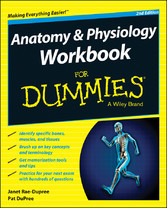
Anatomy and Physiology Workbook For Dummies
von: Janet Rae-Dupree, Pat DuPree
For Dummies, 2014
ISBN: 9781118940082
Sprache: Englisch
336 Seiten, Download: 7817 KB
Format: EPUB, auch als Online-Lesen
Chapter 1
The Chemistry of Life
In This Chapter
Getting to the heart of all matter: Atoms
Checking into chemical reactions and compounds
Making sense of metabolism
We can hear your cries of alarm. You thought you were getting ready to learn about the knee bone connecting to the thigh bone. How in the heck does that involve (horrors!) chemistry? As much as you may not want to admit it, chemistry — particularly organic chemistry, the branch of the field that focuses on carbon-based molecules — is a crucial starting point for understanding how the human body works. When all is said and done, the universe boils down to two fundamental components: matter, which occupies space and has mass; and energy, the ability to do work or create change. In this chapter, we review the interactions between matter and energy to give you some insight into what you need to know to ace those early-term tests.
Building from Scratch: Atoms and Elements
All matter — be it solid, liquid, or gas — is composed of atoms. An atom is the smallest unit of matter capable of retaining the identity of an element during a chemical reaction. An element is a substance that can’t be broken down into simpler substances by normal chemical reactions. There are 98 naturally occurring elements in nature and 20 (at last count) artificially created elements for a total of 118 known elements. However, additional spaces have yet to be filled in on the periodic chart of elements, which organizes all the elements by name, symbol, atomic weight, and atomic number. The key elements of interest to students of anatomy and physiology are
- Hydrogen: Symbol H
- Oxygen: Symbol O
- Nitrogen: Symbol N
- Carbon: Symbol C
HONC your horn for the four organic elements. These four elements make up 96 percent of all living material.
Atoms are made up of the subatomic particles protons and neutrons, which are in the atom’s nucleus, and clouds of electrons orbiting the nucleus. The atomic weight, or mass, of an atom is the total number of protons and neutrons in its nucleus. The atomic number of an atom is its number of protons; conveniently, atoms that are electrically neutral have the same number of positive charges as negative charges. Opposite charges attract, so negatively charged electrons are attracted to positively charged protons. The attraction holds electrons in orbits outside the nucleus. The more protons there are in the nucleus, the stronger the atom’s positive charge is and the more electrons it can attract.
Simplified models assume that electron particles orbit the nucleus at different energy levels, known as shells (see Figure 1-1). But quantum theory best describes information about electron-states using wave functions, or orbitals. Each orbital has a four-quantum-number address (characteristic energy, 3-D shape, orientation, and spin). The principal quantum number is the shell. The other numbers allow room to add distinct electrons. Shells are divided into subshells, and these are filled to completion in order of increasing energy.
- The first shell holds only two electrons, of opposite spin (magnetism).
- The second and third shells each hold eight electrons in four subshells and two spins.
- The fourth shell (which can be found in elements such as potassium, calcium, and iron) holds up to 18 electrons. Higher shells also exist.
© John Wiley & Sons, Inc.
Figure 1-1: Grouping electrons into shells or orbits.
Other key chemistry terms that you need to know are
- Isotopes: Atoms of an element that have a different number of neutrons and a different atomic weight than usual. In other words, isotopes are alternate forms of the same chemical element, so they always have the same number of protons as that element but a different number of neutrons.
- Ions: Because electrons are relatively far from the atomic nucleus, they are most susceptible to external fields. Atoms that have gained or lost electrons are transformed into ions. Getting an extra electron turns an atom into a negatively charged ion, or anion, whereas losing an electron creates a positively charged ion, or cation.
To keep anions and cations straight, think like a compulsive dieter: Gaining is negative, and losing is positive.
- Acid: A substance that becomes ionized when placed in solution, producing positively charged hydrogen ions, H+. An acid is considered a proton donor. (Remember, atoms always have the same number of electrons as protons. Ions are produced when an atom gains or loses electrons.) Stronger acids separate into larger numbers of H+ ions in solution.
- Base: A substance that becomes ionized when placed in solution, producing negatively charged hydroxide ions, OH–. Bases are referred to as being more alkaline than acids and are known as proton acceptors. Stronger bases separate into larger numbers of OH– ions in solution.
- pH (potential of hydrogen): A mathematical measure on a scale of 0 to 14 of the acidity or alkalinity of a substance. A solution is considered neutral, neither acid nor base, if its pH is exactly 7. (Pure water has a pH of 7.) A substance is basic if its pH is greater than 7 and acidic if its pH is less than 7. The strength of an acid or base is quantified by its absolute difference from that neutral number of 7. This number is large for a strong base and small for a weak base. Interestingly, skin is considered acidic because it has a pH around 5. Blood, on the other hand, is basic with a pH around 7.4.
Answer these practice questions about atoms and elements:
1. What are the four key elements that make up most living matter?
a. Carbon, hydrogen, nitrogen, and phosphorus
b. Oxygen, carbon, sulfur, and nitrogen
c. Hydrogen, nitrogen, oxygen, and carbon
d. Nitrogen, potassium, carbon, and oxygen
2. Among the subatomic particles in an atom, the two that have equal weight are
a. neutrons and electrons.
b. protons and neutrons.
c. positrons and protons.
d. neutrons and positrons.
3. For an atom with an atomic number of 19 and an atomic weight of 39, the total number of neutrons is
a. 19.
b. 20.
c. 39.
d. 58.
4. Element X has 14 electrons. How many electrons are in its outermost shell?
a. 2
b. 6
c. 14
d. 4
5. A substance that, in water, separates into a large number of hydroxide ions is
a. a weak acid.
b. a weak base.
c. a strong acid.
d. a strong base.
6. A hydroxide ion has an oxygen atom as well as
a. a hydrogen atom.
b. an extra electron.
c. a hydrogen atom and an extra electron.
d. a hydrogen atom and one less electron.
7.–12. Fill in the blanks to complete the following sentences:
Different isotopes of the same element have the same number of 7. _______________ and 8. _______________ but different numbers of 9. _______________. Isotopes also have different atomic 10. _______________. An atom that gains or loses an electron is called an 11. _______________. If an atom loses an electron, it carries a 12. _______________ charge.
Compounding Chemical Reactions
A chemical reaction is the result of a process that changes the number, the types, or the arrangement of atoms within a molecule. The substances that go through this process are called the reactants. The substances produced by the reaction are called the products. Chemical reactions are written in the form of an equation, with an arrow indicating the direction of the reaction. For instance: A + B → AB. This equation translates to: Atom, ion, or molecule A plus atom, ion, or molecule B yields molecule AB.
In the following sections, we describe the chemical bonds that hold together molecules and the organic compounds created by chemical reactions.
Chemical bonds
Atoms tend to arrange themselves in the most stable patterns possible, which means that they have a tendency to complete or fill their outermost electron orbits. They join with other atoms to do just that. The force that holds atoms together in collections known as molecules is referred to as a chemical bond. There are two main types and some secondary types of chemical bonds:
- Ionic bond: This chemical bond (shown in Figure 1-2) involves a transfer of an electron, so one atom gains an electron while one atom loses an electron. One of the resulting ions carries a negative charge (anion), and the other ion carries...










